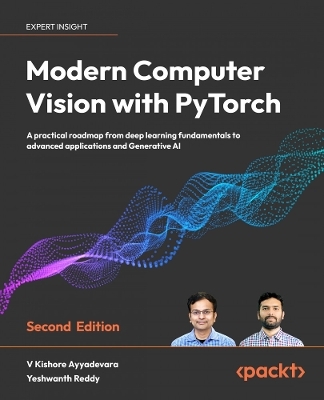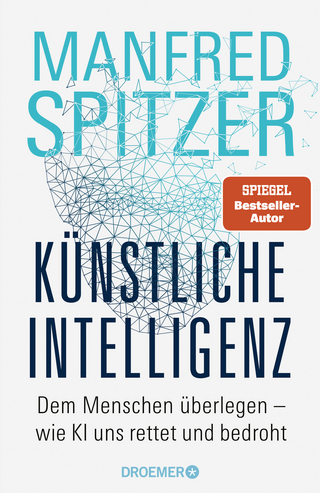
Modern Computer Vision with PyTorch
Packt Publishing Limited (Verlag)
978-1-80323-133-4 (ISBN)
Purchase of the print or Kindle book includes a free eBook in PDF format
Key Features
Understand the inner workings of various neural network architectures and their implementation, including image classification, object detection, segmentation, generative adversarial networks, transformers, and diffusion models
Build solutions for real-world computer vision problems using PyTorch
All the code files are available on GitHub and can be run on Google Colab
Book DescriptionWhether you are a beginner or are looking to progress in your computer vision career, this book guides you through the fundamentals of neural networks (NNs) and PyTorch and how to implement state-of-the-art architectures for real-world tasks.
The second edition of Modern Computer Vision with PyTorch is fully updated to explain and provide practical examples of the latest multimodal models, CLIP, and Stable Diffusion.
You’ll discover best practices for working with images, tweaking hyperparameters, and moving models into production. As you progress, you'll implement various use cases for facial keypoint recognition, multi-object detection, segmentation, and human pose detection. This book provides a solid foundation in image generation as you explore different GAN architectures. You’ll leverage transformer-based architectures like ViT, TrOCR, BLIP2, and LayoutLM to perform various real-world tasks and build a diffusion model from scratch. Additionally, you’ll utilize foundation models' capabilities to perform zero-shot object detection and image segmentation. Finally, you’ll learn best practices for deploying a model to production.
By the end of this deep learning book, you'll confidently leverage modern NN architectures to solve real-world computer vision problems.What you will learn
Get to grips with various transformer-based architectures for computer vision, CLIP, Segment-Anything, and Stable Diffusion, and test their applications, such as in-painting and pose transfer
Implement multi-object detection and segmentation
Combine CV with NLP to perform OCR, key-value extraction from document images, visual question-answering, and generative AI tasks
Leverage foundation models to perform object detection and segmentation without any training data points
Learn best practices for moving a model to production
Who this book is forThis book is for beginners to PyTorch and intermediate-level machine learning practitioners who want to learn computer vision techniques using deep learning and PyTorch. It's useful for those just getting started with neural networks, as it will enable readers to learn from real-world use cases accompanied by notebooks on GitHub. Basic knowledge of the Python programming language and ML is all you need to get started with this book. For more experienced computer vision scientists, this book takes you through more advanced models in the latter part of the book.
Kishore Ayyadevara is an entrepreneur and a hands-on leader working at the intersection of technology, data, and AI to identify and solve business problems. With over a decade of experience in leadership roles, Kishore has established and grown successful applied data science teams at American Express and Amazon, as well as a top health insurance company. In his current role, he is building a start-up focused on making AI more accessible to healthcare organizations. Outside of work, Kishore has shared his knowledge through his five books on ML/AI, is an inventor with 12 patents, and has been a speaker at multiple AI conferences. Yeshwanth Reddy is a highly accomplished data scientist manager with 9+ years of experience in deep learning and document analysis. He has made significant contributions to the field, including building software for end-to-end document digitization, resulting in substantial cost savings. Yeshwanth's expertise extends to developing modules in OCR, word detection, and synthetic document generation. His groundbreaking work has been recognized through multiple patents. He has also created a few Python libraries. With a passion for disrupting unsupervised and self-supervised learning, Yeshwanth is dedicated to reducing reliance on manual annotation and driving innovative solutions in the field of data science.
Table of Contents
Artificial Neural Network Fundamentals
PyTorch Fundamentals
Building a Deep Neural Network with PyTorch
Introducing Convolutional Neural Networks
Transfer Learning for Image Classification
Practical Aspects of Image Classification
Basics of Object Detection
Advanced Object Detection
Image Segmentation
Applications of Object Detection and Segmentation
Autoencoders and Image Manipulation
Image Generation Using GANs
Advanced GANs to Manipulate Images
Training with Minimal Data Points
Combining Computer Vision and NLP Techniques
Combining Computer Vision and Reinforcement Learning
Stable Diffusion
Applications of Stable Diffusion
Moving a Model to Production
| Erscheinungsdatum | 08.08.2023 |
|---|---|
| Verlagsort | Birmingham |
| Sprache | englisch |
| Maße | 191 x 235 mm |
| Themenwelt | Informatik ► Theorie / Studium ► Künstliche Intelligenz / Robotik |
| ISBN-10 | 1-80323-133-5 / 1803231335 |
| ISBN-13 | 978-1-80323-133-4 / 9781803231334 |
| Zustand | Neuware |
| Haben Sie eine Frage zum Produkt? |
aus dem Bereich


